One of the implicit values in our Buffer marketing is to challenge assumptions.
And one of the biggest assumptions I have about our content is that we should be publishing original articles to the blog multiple times each week.
Well … what might happen if we didn’t?
To find out, we stopped publishing new content for 30 days, focusing instead on repurposing and refreshing our content from the archives. I’d love to share with you every single thing we tried and all that we learned, both what worked and what didn’t.

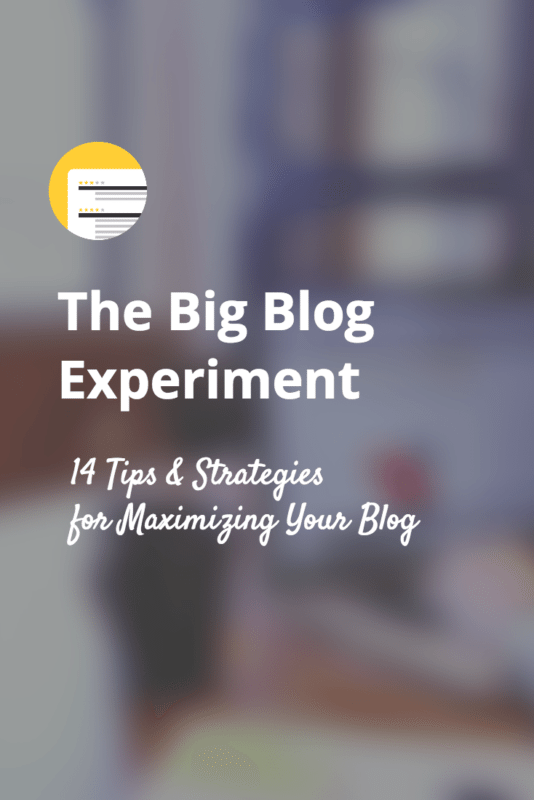
tl;dr – Our top takeaways
I’d love to share at the top here how the experiment went and then get into a lot more detail below for anyone interested in the specifics.
Having not published original content on the blog for 30 days, we saw only a 4 percent dip in traffic compared to the previous month.
The extra time off allowed us to experiment with content in some amazing ways. Our most successful experiments were these:
- Create new email drip campaigns based on Buffer blog posts
- Update older blog posts with new information, graphics
- Create SlideShares
- Republish content to Medium
- Bundle tools posts into Product Hunt collections
I’m happy to explain fully how we went about this experiment and all of the 14 strategies that we tried. And happy to clarify anything in the comments!
The experiment: No new content for 30 days
The seed of this idea came several months before when Courtney and I were chatting about marketing strategies. We wondered, half-jokingly even, what it might be like to stop publishing on the blog for a month. Could we get by with simply promoting our past content and trusting on traffic from search and social?
The more we thought about the idea, the more it seemed like something we wanted to try, particularly to learn what might happen.
So we came up with a plan:
We’d publish no new content on the blog for four consecutive weeks.
Instead of new content, we’d repurpose our evergreen content and update old blog posts. We’d create resources like slideshares and ebooks and email courses. We’d republish popular posts that could use a bit of a refresh.
We also wanted to be mindful of the effect of such a big experiment, so we thought about the following:
- How will this feel for the blog audience?
- How can we make this a good experience for readers?
- Is there a way we can continue to remain in touch with our RSS email subscribers?
- How will this impact our social media sharing, if there’s nothing new to share?
The timing felt great for us to try this in July as summer months are typically a lower traffic time for the blog and July was our team retreat to Iceland where we enjoy spending time with one another and chatting more high level about things (and a little less blog post writing).
During the planning process, seasonality played a part in the decision also. Our assumption was that the summer months see less traffic to the blog, which might make it the perfect time to experiment.
Turns out, I made a big assumption there! Looking at the numbers in hindsight, summer is not necessarily any less busy than other months. Here is a look at January through July of last year, where you can see that July had the third-most traffic.
- July 2014 – 698,886
- June 2014 – 600,337
- May 2014 – 679,021
- April 2014 – 710,639
- March 2014 – 717,070
- February 2014 – 600,630
- January 2014 – 654,126
A quick look at our month of no new content
In actuality, we ended up publishing 10 articles to the blog, none of them fully brand new. Here’s the list of content from those four weeks:
Week One
- The Big List of Twitter Tools: 91 Free Twitter Tools and Apps to Fit Any Need (an update to our popular tools post)
- A Scientific Guide to Hashtags: How Many, Which Ones, and Where to Use Them (an update, with a new audio version of the post)
- Got 60 Seconds? Learn Something New in These 25 Short & Sweet Social Media SlideShares (a listicle with new SlideShares we’d created from evergreen content)
Week Two
- The 15 Best Browser Extensions to Improve Your Social Media Marketing (an update to a popular tools post)
- Twitter Tips for Beginners: Everything I Wish I Knew About Twitter When I Started (an update)
- The Big List of IFTTT Recipes (an update)
Week Three
- How to Create a Social Media Marketing Plan From Scratch (an update with a brand new infographic)
- LinkedIn Marketing: The All-in-One Guide to Scheduling and Writing the Best Updates (an update to an outdated post)
Week Four
- 25 Actionable Social Media Strategies You Can Implement Today (an ebook based on past blog posts)
- The Ultimate List of Product Hunt Collections (a roundup of our popular tools posts, repurposed into PH collections)
The results
I think the big question that came to mind for me with this experiment was:
What might happen to the blog’s traffic?
Here’s a look:
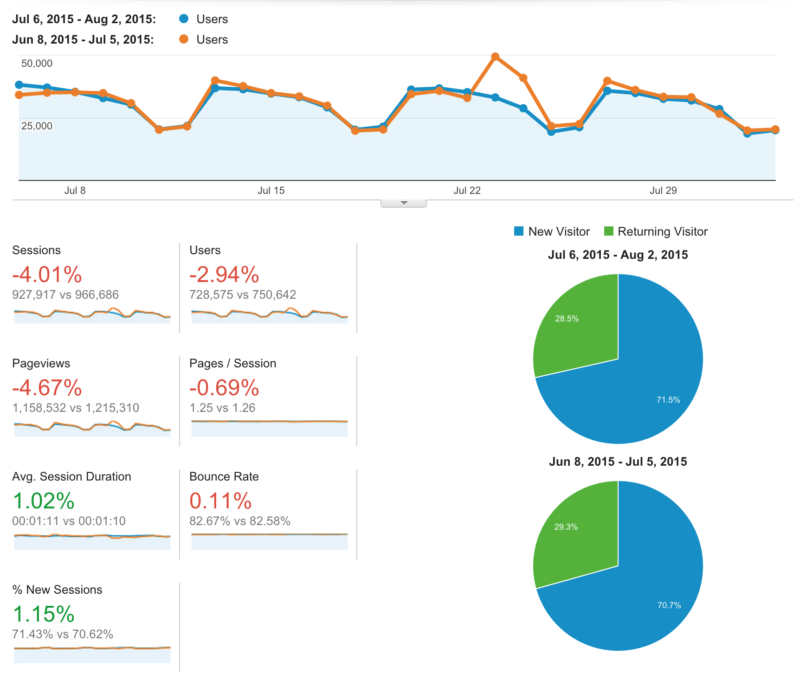
Overall, traffic dipped – though not in a hugely significant way.
In fact, the previous month we saw a big spike on Thursday, June 25, which brought 16,000 more folks than usual to the blog. If that had been a normal day, the month-to-month comparison on unique visits would have been just 6,000 apart.
The effect of search and social traffic
My hunch going into the experiment was that traffic from search would stay fairly consistent during the month, perhaps even with a positive bump or two from the evergreen posts that we’d refreshed and improved.
Here’s what happened there:

Turns out that traffic from organic search was up!
Referral traffic was another area I thought might have an impact. The thought was that if we were taking the time to invest in content at places like Medium and SlideShare that referral traffic from those sites would go up, leading to more traffic to the blog.
Here’s what happened, first with referral traffic:

And here with social traffic:

Both traffic sources were lower than the previous month, and the social traffic took a big dip.
My theory here: since there were fewer brand new original articles on the blog, people had fewer choices of what to share. We continued sharing our evergreen content via the Buffer channels, which certainly helps, though the impact from not having fresh content for others to circulate definitely had an impact on traffic.
The different strategies we tried
One of the most exciting elements of this experiment for me was brainstorming all the many different ways we could morph our content. We’d written previously about repurposing strategies, all of which seemed great to try. And we came up with some brand new thoughts also.
Here’s the full list:
- Update older blog posts with new information, graphics
- Create SlideShares
- Republish content to Medium
- Republish content to LinkedIn Pulse or a LinkedIn group
- Republish content to Quora
- Create video content from blog posts
- Create audio content from blog posts
- Create ebooks based on Buffer blog posts
- Create new email drip campaigns based on Buffer blog posts
- Build an MVP version of a learning center for greater discoverability of posts
- Create infographics
- Create Pinterest images
- Bundle tools posts into Product Hunt collections
- Experiment with email communication with our RSS list
One thing I found interesting from this great list of repurposing ideas is that I failed to anticipate how much time each of these strategies can take.
I failed to accomplish a big chunk of strategies I had hoped to get to.
Here’s the full list of what I had jotted down for our experiment. You can see how many checkboxes remain unchecked!
How we identified our most popular content
To discover which posts to tackle first, I quickly pulled together a spreadsheet with our most popular posts from the blog in terms of social shares and traffic.
Here’s what this process looked like:
- First, I first went to BuzzSumo and searched for buffer.com/resources, which showed me a ranking of how all our content performed in terms of social shares.
- From the BuzzSumo results page, I was able to export the data, which gave me total social shares, as well as shares for each individual network—Twitter, Facebook, LinkedIn, Google+, and Pinterest.
- I placed this data into a Google spreadsheet.
- Then I added Google Analytics as an add-on to the sheet, which allowed me to pull in traffic stats.
- After adding this, I went to the Google Analytics add-on and asked it to grab unique visits based on the URL for each page in the spreadsheet. I also grabbed Time on Page.
Here’s the resulting spreadsheet. Feel free to make a copy and use however you see fit! (And I’d love to help clarify any of the steps above if I can be of help in the comments.)
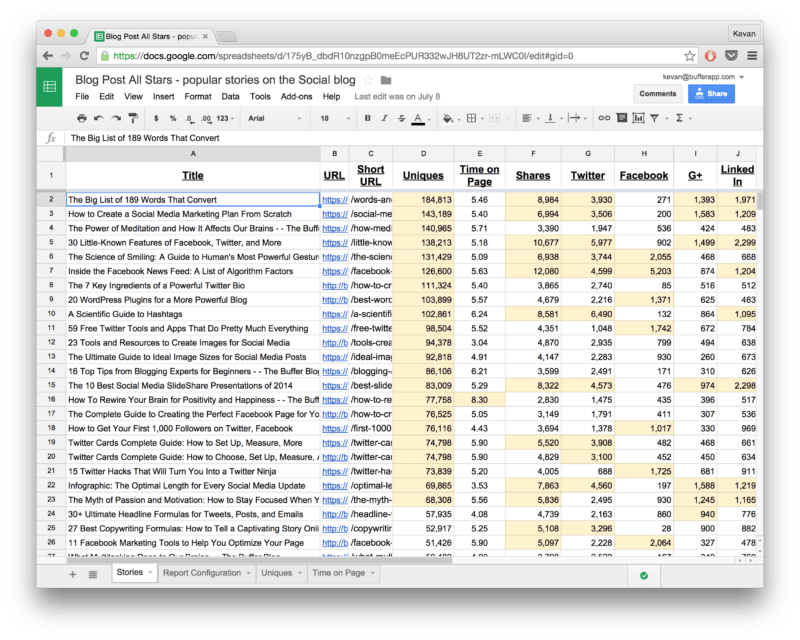
How each strategy performed
1. Update older blog posts with new information, graphics
The idea here was somewhat straightforward: Take some of our most popular blog posts from the archives and update them with accurate, new information and up-to-date graphics.
Once we’d refreshed a post, we’d then add a note to the top of the article saying that we’d made some updates. Then we’d change the publish date from the original date to today’s date. And voila! The new (old) article would appear at the top of the blog.
(Click here for an example.)
How it went
We were excited to try this strategy so that our most popular posts would continue to be helpful for people. And by that metric, it performed great! We’re always up for any strategy that adds more value for our audience.
In terms of traffic impact, we had a hunch that there may be SEO benefits to adding more media and info to your content, as well as changing the publish date.
Slideshares and audio can potentially boost the SEO power of a page. Here’s how Brian Dean of Backlinko explains it:
Multimedia has a nice SEO benefit to boot: it helps you boost those user-interaction signals that Google has been paying more attention to. And it increases the perceived value of your content: which means that people are more likely to link to it.
And as for the publish date, I know for myself that I often filter Google results by time frame so that I’m looking at the newest posts.
We didn’t quite run a before-and-after SEO analysis for these pages, so the takeaways here are mostly conjecture. Still, it felt worth our time to update this content so that it was fully accurate and to surface this evergreen info for people who might not have seen it before.
A couple notes about how this went, technically-speaking:
- We ran into a slight snag with the RSS feed. Changing the date seemed to add the post back into the RSS feed in almost all situations, except for Feedly. At Feedly, these refreshed posts did not appear, which I’m sorry was likely a poor experience for our Feedly subscribers.
- Since the RSS updated well in most places, we didn’t have to change much in terms of our automated RSS emails or other feeds.
2. Create SlideShares
We’ve noticed great things from SlideShare for our Buffer slide decks in the past. A few of them have received 100,000 views or more, which equals the views on some of our most popular blog posts!
For this bit of repurposing, I went with a list of our top posts and did my best to convert the articles into slides.
I ended up creating ones for Twitter Tips for Beginners, Words That Convert, and Ultimate List of Twitter Tools.
These new SlideShares were added directly into the older posts, and some of the posts were shared again along with newly updated information.
How it went
The three new SlideShares got 199,000 total views!
Here’s the full breakdown:
- Twitter Tips for Beginners – 32,153
- Words That Convert – 58,765
- Ultimate List of Twitter Tools – 109,131
Our referral traffic from SlideShare last month jumped from 50 visits to 90 visits. The overall traffic remained somewhat small—SlideShare was our #18 social media referrer, behind spots like paper.li, Blogger, and Yammer, where we do very little.
Still, this feels like great validation to keep moving fast with creating SlideShares for our Buffer content and even exploring cool ways to generate leads via SlideShare (their premium plans allow you to prompt viewers for an email address).
The total time it takes me to create these is small—two or three hours in Canva pulling images and content together.
(Would it be helpful to see our SlideShare workflows at all? Happy to share those in a separate blog post!)
3. Republish content to Medium
We’ve been really excited to grow our strategy on Medium. We have in mind a cool place where we can republish content as well as maybe explore some new, perhaps short-form ways of connecting with you all about the latest social media news.
For last month, our focus was mostly on republishing. We’ve built a collection of social media posts on Medium, and the goal was to add many more to the list.
I ended up adding only the one: 15 Psychological Studies for Social Media Marketers to Know.
15 Psychological Studies for Social Media Marketers to Know
Republishing to Medium is incredibly easy, by the way. Once you’re logged in, you simply need to click on your profile picture in the top right corner and select Import.
Then copy and paste the link to your blog post, and Medium will add it directly as a draft.
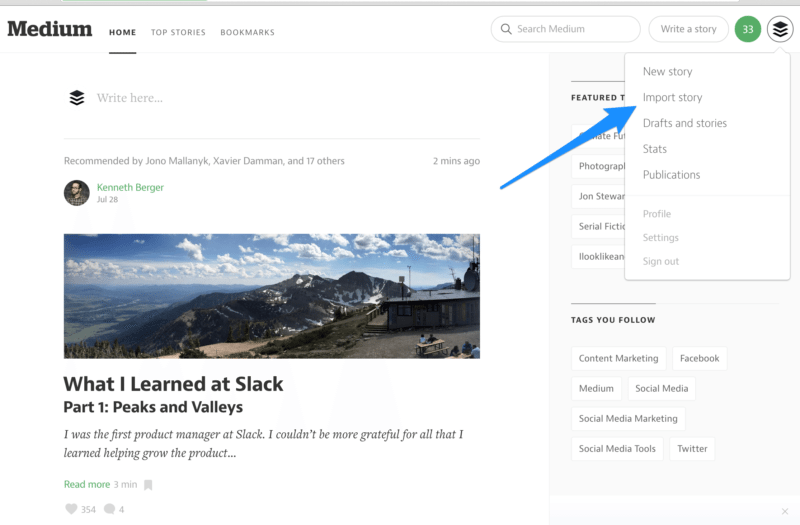
We like to format the post slightly and add a CTA at the end that ties back into our email list at Buffer.
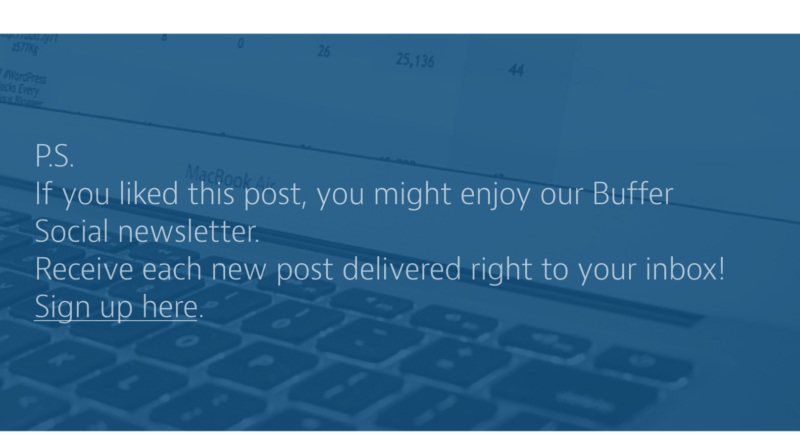
How it went
Amazing! The one post we did ended up among Medium’s Top 20 for the day, which allowed it to get some great exposure on the Medium homepage and in emails.
In total, the post was viewed 2,888 times—1,104 views on the first full day of publish.
In terms of those who read through the full article, 580 people read the whole thing, and 177 folks hit recommend. All the numbers were the highest for any post we’d published before on Medium.
4. Republish content to LinkedIn Pulse or a LinkedIn group
LinkedIn Pulse is a lot like Medium in terms of republishing older content. A lot of individuals use it for resharing their older posts (many people write original content there as well).
Because of the nature of LinkedIn’s emphasis on individuals here, I was never quite sure how to implement LinkedIn Pulse with Buffer.
Can I write Pulse articles as Buffer, the company? Not quite.
Would it have made sense for me to republish content on LinkedIn Pulse as me, Kevan? Not sure.
We didn’t end up publishing anything to LinkedIn Pulse.
And the same for LinkedIn groups.
Starting a group from scratch ended up being too big of a task to take on during the month. I’d be keen to hear from anyone who has tried either Pulse or groups! I’d love to learn from your experience!
5. Republish content to Quora
Quora is another exciting channel I’d love to do better on. Buffer’s co-founders Joel and Leo have been so great and quick with answers to Buffer questions, remote work/startup questions, and more.
A bit like LinkedIn Pulse, Quora emphasizes the contributions of individuals, not companies/brands. So again, I found myself in a bit of an awkward spot, wondering how I might be able to repurpose Buffer’s content on a site where Buffer can’t really post anything for itself. I ended up going the route of answering a few questions individually, referencing Buffer content in my answers.
How it went
I answered two questions, and my answers were seen by 211 people.
I managed to get one of the two answers to the top of its thread for the question: “How do I set up a social media strategy for my company?” (It felt like a good win, even though I only needed two upvotes to make it to the top.)
The social media strategy answer gained two clicks back to the blog.
The other answer brought zero.
In terms of overall traffic from Quora back to the Buffer blog, it was kind of wash: Pageviews were up for the month, but uniques were down.
As kind of a side note here, I will say that my experience at Quora was really amazing and smooth. Quora makes it simple to find categories and topics you might like to join, and you can add questions to a queue to follow or answer later. Super helpful!
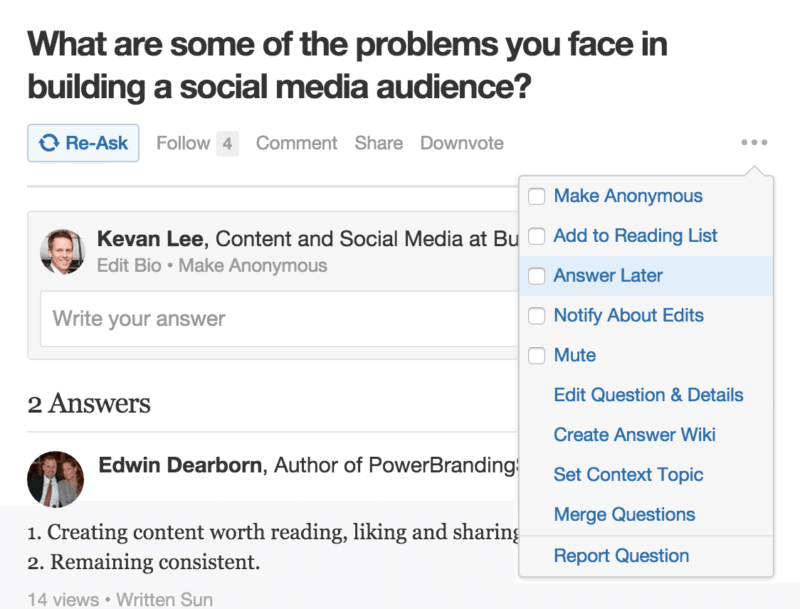
6. Create video content from blog posts
We didn’t quite get around to trying this one out, though just lately we’ve dipped a bit into video for our latest email course. You can check out the course here. I’ve placed a video below. Would love to hear your thoughts and input!
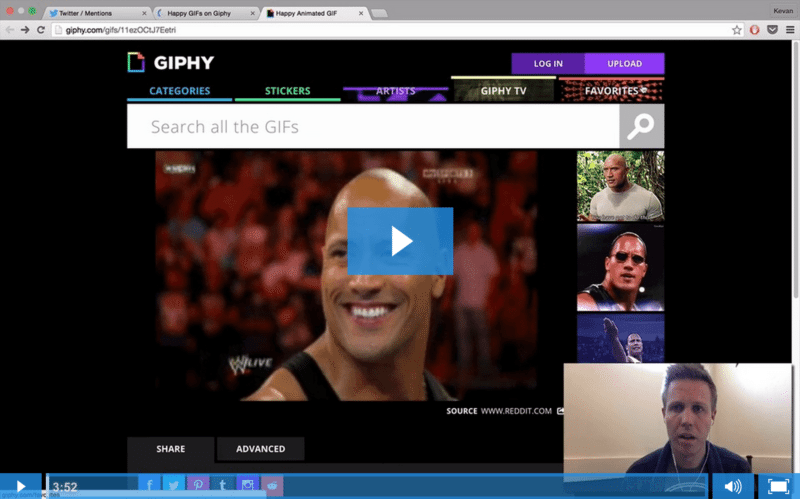
7. Create audio content from blog posts
Super fun one! We’re currently exploring what a podcast might look like at Buffer, and one of our ideas for a very early experiment was to simply provide audio versions of blog posts.
We tried this with our post on hashtags, inviting our teammate Adam to read and record it.
How it went
The audio received 867 plays, and the response and excitement for the audio was really excellent.

As for time involved, I’ll have to cede to Adam a bit on this one. He did mention that the first go-round took a few hours while he got used to the equipment and the software. Future recordings will likely be a lot faster.
Would you be interested in audio versions of blog posts? Let us know, and we’ll make some more for you!
8. Create ebooks based on Buffer blog posts
We’d created one Buffer ebook previously. It had around 2,000 downloads and didn’t exactly feel like something that was super validated afterward.
Still, I thought we could try again.
I bundled 25 of our best social media tips into an ebook. All the tips were ones I grabbed from old blog posts, and I threw everything into a Google Doc, which I formatted slightly with headings and page breaks. I added an image at the beginning of each chapter, and I created a cover image in Canva. Then I exported the Google Doc as a pdf. Voila!
It was quite a lean process, which I reflected on later might have not been the best route to go. It seems like some of the most successful ebooks are the ones that are highly professional and well-polished. I’m afraid my book was neither.
To promote the book, we published a blog post, and I created a new MailChimp list that would send out the ebook right away.
Total time involved here: 6 to 8 hours.
How it went
The ebook brought in 2,397 signups and downloads.
By comparison, we got three to four times that engagement with our first email course, and it seems that some of the other repurposing strategies mentioned above have yielded a bit greater results so far for us.
9. Create new email drip campaigns based on Buffer blog posts
(A drip campaign is a series of emails that are sent to inboxes slowly over a period of time, say once per day for 14 days.)
We’d experimented a bit with drip campaigns before. Those who sign up to receive blog updates from us get a few of our most popular posts sent over their first few days.
And our 7-day Social Media 101 email course is set up as a drip campaign.
For our latest experiment, I wanted to build on the momentum from the 101 course with something a bit more robust.
So I went with a 25-day video course, all about social media strategies.
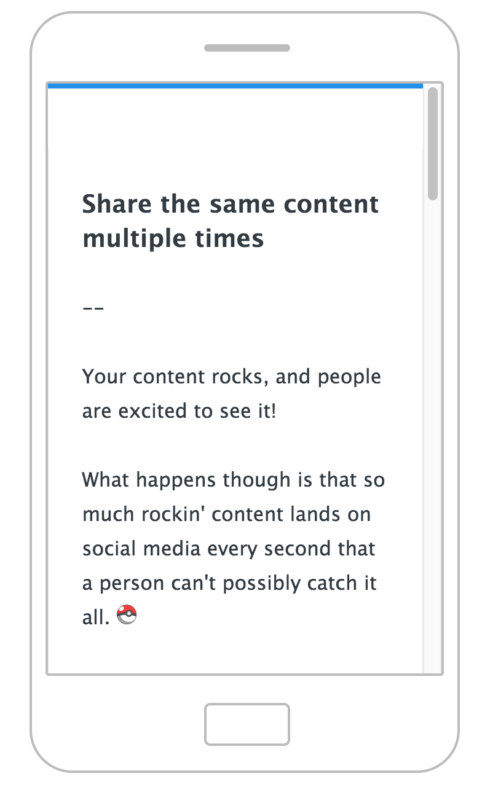
If this sounds a bit familiar, the topic is the same as that of the ebook we made. And the content is quite similar, too. The ebook began as the email course. We learned from our 101 course that having a pdf of all the lessons at the end of the course might be a cool move. So I went ahead and did it, creating a pdf of all the lessons and then spinning off the pdf into an ebook.
But first things first, the drip campaign. Here’s how I went about setting it up.
- I went through our blog posts and pulled out the 25 best strategies I could find.
- I added all these strategies into a big collaborative doc (we use Hackpad here at Buffer), numbering the tips and adding subject lines and P.S. messages to each.
- I opened up MailChimp and started a new Automation workflow.
- I set up the workflow to send a new email one day after a previous email had been sent, and to do so on Monday through Friday only.
- I copied over all the content from the hackpad into new emails for the automation workflow. I ended up with 29 tips, so I tacked on a few bonus lessons at the end of the original 25 days.
- I created a landing page for the course so that people could sign up.
- I wrote an announcement blog post.
- I crossed my fingers and hoped people might like it!
How it went
Amazing, amazing, amazing. These email courses have been such an exciting project for us. The first course has had 17,817 signups. This latest course, after six days, has 18,185 signups!
People are opening the emails and engaging with the content—a 60 percent open rate so far.
What’s more is that the course has proven to be a great chance to validate video a bit. We’ve included for the first time some video content with these lessons, and within the first two days the videos were going so great we needed to upgrade our Wistia account for more bandwidth.
(One behind-the-scenes tidbit about the videos is that I hadn’t really created any when I launched the course! A few hours before the first email was to go out, I recorded and uploaded the first video. I’ve been working one day ahead ever since—the course is six days old, so I’m recording video #7 tonight. ? I’m quite grateful for drip courses to give me this flexibility!)
10. Build an MVP version of a learning center for greater discoverability of posts
One thing we’ve noticed about the Social blog is that it can be a bit difficult to dig through and find helpful content from the archives. If you arrive at our site wanting to learn about Facebook marketing, for instance, there’s not really an easy place to go.
Our theory is that a sort of learning center or hub might help fix this.
I was able to create a very early version of a learning center. It’s basically a landing page with some title cards that link to different tags and categories on the blog.
Feel free to check it out here if you’d like.
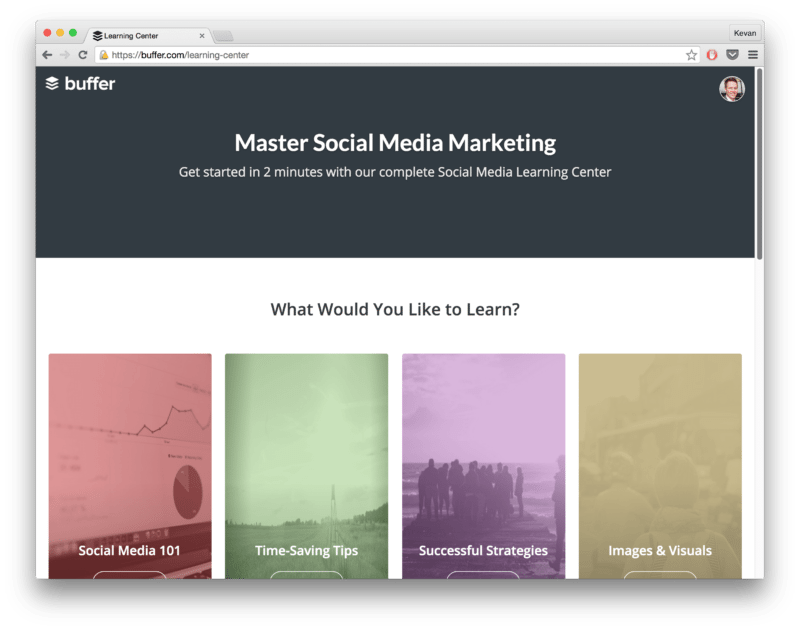
How it went
We’re linking to this page in only a very few places, most notably from the FAQ in our help section. So far, the page has received 1,030 visits.
One thing we’d love to learn from this page is what type of answers people are most looking for, i.e. which cards are people clicking on the most.
To date, these are the most popular cards:
- Twitter Tips – 83
- Time-Saving Tips – 79
- Facebook Tips [Beginner] – 62
- Facebook Tips [Advanced] – 62
- Images & Visuals – 58
- Successful Strategies – 50
11. Create infographics
We’re super high on visual content for the success of a blog post and for social media. Our first infographic (a fun collaboration with SumAll) did really great – nearly 8,000 social media shares to the article. We’ve done a few more since, also.
For our no-new-content month, we had the privilege of partnering with Venngage on an infographic. They worked something up for one of our most popular posts—How to Create a Social Media Marketing Plan From Scratch.
Here is a snippet:
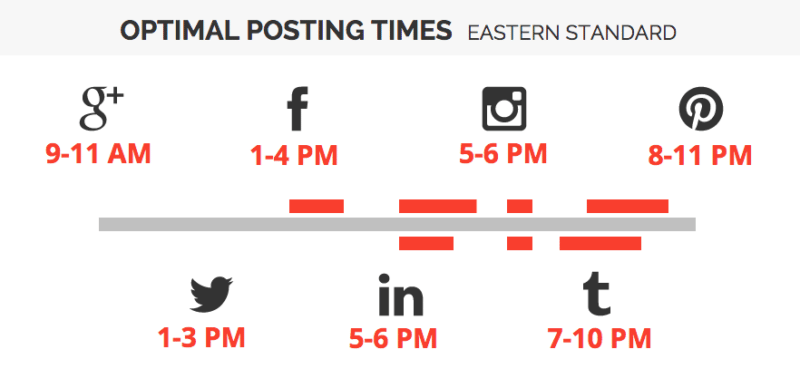
How it went
The infographic was a lot of fun to feature, and we’ve since used cut-ups of the graphic in a number of different places (email courses is one of those places).
In terms of traffic and shares, it’s a bit hard to tell how well this one did for us, which is all my fault for not approaching this very scientifically. Since we added the infographic to an existing post, the existing post brought with it a fair deal of shares already.
In terms of new traffic, we saw 27,597 visits since the post was refreshed.
One theory I have here is that with infographics it might be great to find a way to have a consistent brand and image on all of them. We’ve been fortunate to have a lot of great folks helping us out with these. I often look for inspiration to the Quick Sprout blog, which has some really amazing graphics that have a clean and consistent look.
I’d love to know if you have any thoughts or tips on this!
12. Create Pinterest images
Now that Buffer has Pinterest integration, we’ve been excited and encouraged to go all out with a Pinterest strategy. This has direct applications to our blog posts, as we’re looking now to create at least one Pinterest-worthy image for each post we publish.
What makes for a Pinterest-worthy image? Here are some of our findings:
- Vertical (portrait) orientation
- At least 600 pixels wide, with 736 pixels being optimal
- Aspect ratio of 2:3 or 1:3.5
- Up to three separate images in a mosaic
- Text overlay on the image
- Rich, descriptive alt text
Here’s a bit about my personal process for creating these.
- I went through and created a main blog image just as I have before: adding a heading and subhead, uploading an icon image, and adding an UnSplash picture to the background (and blurring the background).
- After I’ve downloaded this main image, I click to switch to a tall, vertical image.
- I rearrange the elements here, and I download.
- Boom! An ideal Pinterest image.
How it went
Here are some of the Pinterest stats (via BuzzSumo) on each of the posts we published during the month.
- Product Hunt Collections article – 5 Pins
- LinkedIn Marketing article – 5 Pins
- Strategies Ebook – 2 Pins
- the rest – 0 Pins
13. Bundle tools posts into Product Hunt collections
I noticed that many popular posts on the blog are tools posts. And in finding this out, it got me to thinking that there could be some really neat ways to collect all these tools posts in one place.
Funny enough, a lot of my research for tools posts now happens on Product Hunt. So it seemed like a great opportunity to explore even further the connection there.
I created a Product Hunt account for Buffer, and then I went about creating a Product Hunt collection for each of the tools posts on the blog.
Product Hunt has a great explainer on their site about how to make a collection.
You can make a collection through either a results page …
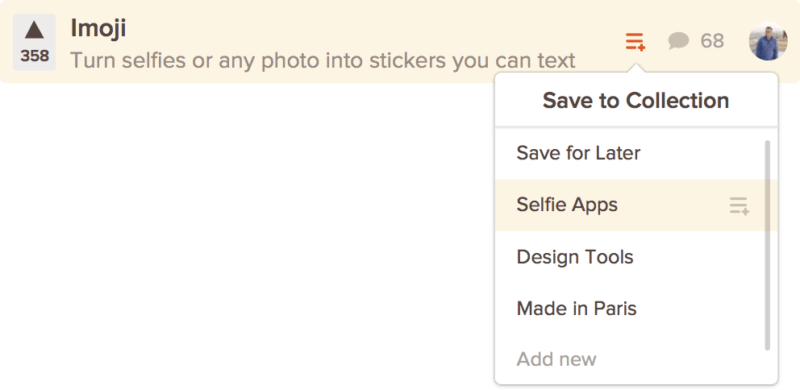
… or from the product’s landing page itself.
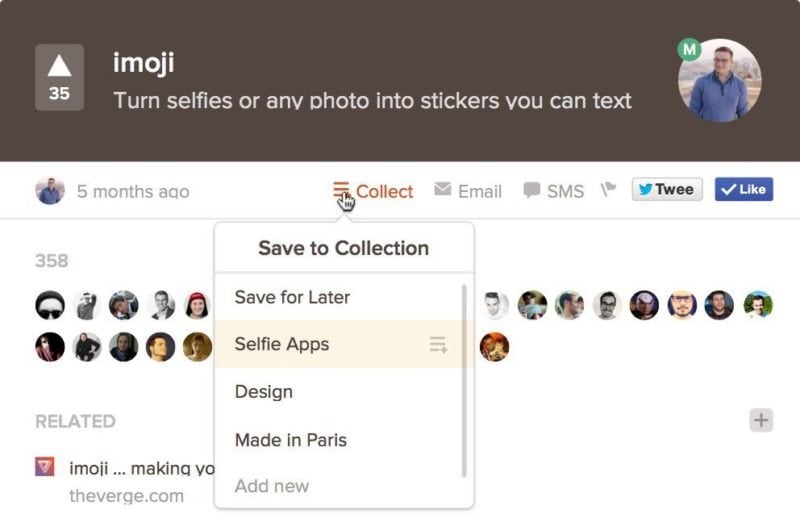
(In some cases for me, there were tools in our blog posts that weren’t yet on Product Hunt. I didn’t worry too much if a product or tool wasn’t up on Product Hunt yet. I aimed more for the novelty of having a collection rather than the completeness of including every single tool in each collection.)
Once I built all the collections, I created a listicle post that mentioned each collection and linked back to the original tools posts.
How it went
The post got 3,207 visits, and there was some pretty cool tangential happenings that made it seem quite successful, too.
Hiten Shah linked to it in his popular SaaS newsletter.
And, hugely and amazingly, Product Hunt founder Ryan Hoover noticed the post and tweeted us about it. Product Hunt was keen to add it to their daily email, which reaches thousands of people!
@kevanlee AWESOME work w/ the PH collections, Kevan. We're sharing one of them in our email digest in 2 mins ? cc @joelgascoigne @LeoWid
— Ryan Hoover (@rrhoover) July 30, 2015
14. Experiment with email communication with our RSS list
A smaller test of ours — and one I’d been very excited to try for some time now — was changing up the way we communicate with our RSS email subscribers.
We typically send a pretty straightforward daily email with a link to our latest blog post.

What I tested this time was a variation where I wrote a personal introduction to the post, plus shared the full content of the post within the email. Here’s what it looks like above the fold:
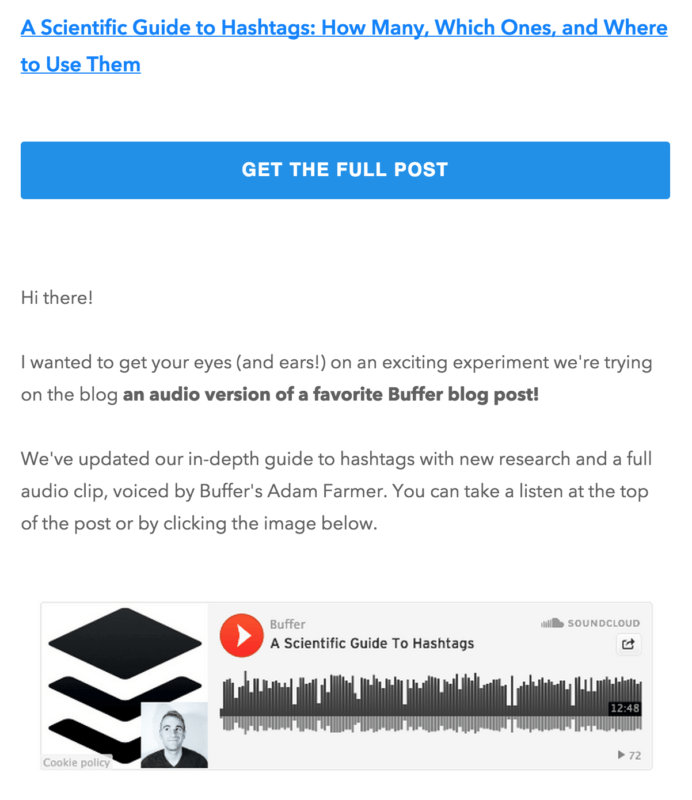
I ran this as an A/B test through MailChimp. One interesting thing to note here is that MailChimp doesn’t have an option to A/B test the content of your email. So my workaround was to split the list into two segments: 1) a group that signed up before May 2014 and 2) a group that signed up after May 2014. One group got the standard email, the other was sent the variation.
Update: A couple days after this post went live, MailChimp announced new A/B testing features, including tests for content! Excited to try this out on future experiments. ?
How it went
The short version: I didn’t see a significant change with the new email.
The long version: I had a spot of trouble being scientific with this one, and that’s all my fault for not thinking it through clearly at the start. At first, the group that received the variation seemed to be significantly more engaged with the emails—20 to 30 percent open rate, 5 to 10 percent click rate. Then I realized that it was entirely possible that the variation group, which made up the more recent subscribers, was a more engaged group in general, seeing how they’d joined more recently.
So I switched the test groups, and that seemed to confirm my theory. Once switched, the variation did poorer than the control version. The newer subscribers were more engaged, no matter which email was sent to them.
How did things go overall?
Before starting, I went about setting some goals for the experiment. At the end of the four-week period, I was hoping for …
- less than 5% drop in unique visits to the blog
- 500% increase in SlideShare views month-over-month
- 500% increase in LinkedIn follows
- 500% increase in Quora views
- 10,000 ebook downloads
- 25,000 video views
- 1 new email drip campaign created
- Learning Center MVP built
And here’s how things went:
- less than 5% drop in unique visits — Actual: 4% drop ?
- 500% increase in SlideShare views — Actual: 116,000 versus 450,000 (380% increase)
- 500% increase in LinkedIn follows — Actual: no significant increase
- 500% increase in Quora views — Actual: 211 versus 0 (I didn’t do my research in setting this goal, huh!)
- 10,000 ebook downloads — Actual: 2,397 downloads
- 25,000 video views — Actual: None during the month, 5,800 since
- 1 new email drip campaign created — Yes! ?
- Learning Center MVP built — Yes ?
I failed big time to do all the things I wanted to do. But ultimately, it felt great to experiment! And I think we learned a ton about what we might want to try—lessons we might never have learned had we stayed heads down on writing new articles.
Overall, if I were to rank and recommend the strategies that we tried over the past 28 days, this is how I might go about it:
- Create new email drip campaigns based on Buffer blog posts
- Update older blog posts with new information, graphics
- Create SlideShares
- Republish content to Medium
- Bundle tools posts into Product Hunt collections
- Create video content from blog posts
- Create audio content from blog posts
- Create infographics
- Republish content to Quora
- Create Pinterest images
- Build an MVP version of a learning center for greater discoverability of posts
- Republish content to LinkedIn Pulse or a LinkedIn group
- Experiment with email communication with our RSS list
- Create ebooks based on Buffer blog posts
I hope this information might be helpful for you as you think about ways to experiment with your content and your strategy!
I’d love to hear any thoughts you might have!
Feel free to leave a comment here. I’d be happy to clarify or add more context to any of the strategies that we tried!
Image sources:UnSplash, IconFinder
Try Buffer for free
190,000+ creators, small businesses, and marketers use Buffer to grow their audiences every month.


